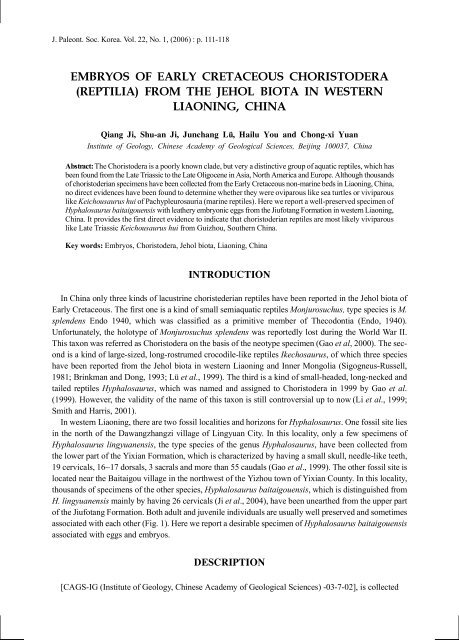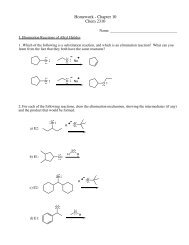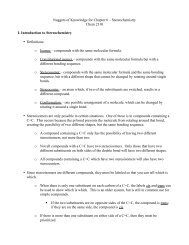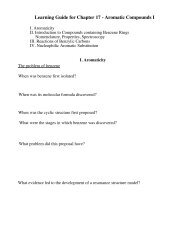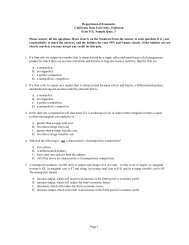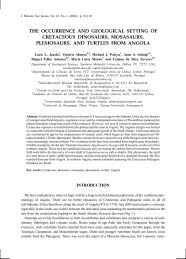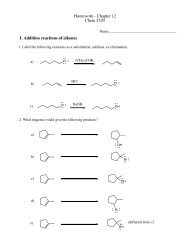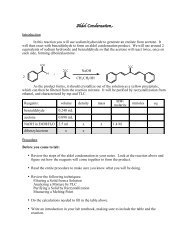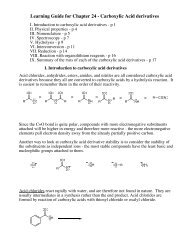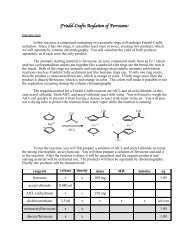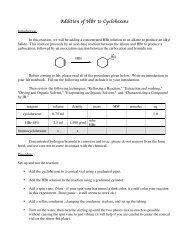EMBRYOS OF EARLY CRETACEOUS CHORISTODERA (REPTILIA ...
EMBRYOS OF EARLY CRETACEOUS CHORISTODERA (REPTILIA ...
EMBRYOS OF EARLY CRETACEOUS CHORISTODERA (REPTILIA ...
You also want an ePaper? Increase the reach of your titles
YUMPU automatically turns print PDFs into web optimized ePapers that Google loves.
J. Paleont. Soc. Korea. Vol. 22, No. 1, (2006) : p. 111-118 ü Institute of Geology, Chinese Academy of Geological Sciences, Beijing 100037, ChinaAbstract: The Choristodera is a poorly known clade, but very a distinctive group of aquatic reptiles, which hasbeen found from the Late Triassic to the Late Oligocene in Asia, North America and Europe. Although thousandsof choristoderian specimens have been collected from the Early Cretaceous non-marine beds in Liaoning, China,no direct evidences have been found to determine whether they were oviparous like sea turtles or viviparouslike Keichousaurus hui of Pachypleurosauria (marine reptiles). Here we report a well-preserved specimen ofHyphalosaurus baitaigouensis with leathery embryonic eggs from the Jiufotang Formation in western Liaoning,China. It provides the first direct evidence to indicate that choristoderian reptiles are most likely viviparouslike Late Triassic Keichousaurus hui from Guizhou, Southern China.Embryos, Choristodera, Jehol biota, Liaoning, ChinaIn China only three kinds of lacustrine choristederian reptiles have been reported in the Jehol biota ofEarly Cretaceous. The first one is a kind of small semiaquatic reptiles Monjurosuchus, type species is M.splendens Endo 1940, which was classified as a primitive member of Thecodontia (Endo, 1940).Unfortunately, the holotype of Monjurosuchus splendens was reportedly lost during the World War II.This taxon was referred as Choristodera on the basis of the neotype specimen (Gao et al, 2000). The secondis a kind of large-sized, long-rostrumed crocodile-like reptiles Ikechosaurus, of which three specieshave been reported from the Jehol biota in western Liaoning and Inner Mongolia (Sigogneus-Russell,1981; Brinkman and Dong, 1993; Lü et al., 1999). The third is a kind of small-headed, long-necked andtailed reptiles Hyphalosaurus, which was named and assigned to Choristodera in 1999 by Gao et al.(1999). However, the validity of the name of this taxon is still controversial up to now (Li et al., 1999;Smith and Harris, 2001).In western Liaoning, there are two fossil localities and horizons for Hyphalosaurus. One fossil site liesin the north of the Dawangzhangzi village of Lingyuan City. In this locality, only a few specimens ofHyphalosaurus lingyuanensis, the type species of the genus Hyphalosaurus, have been collected fromthe lower part of the Yixian Formation, which is characterized by having a small skull, needle-like teeth,19 cervicals, 16~17 dorsals, 3 sacrals and more than 55 caudals (Gao et al., 1999). The other fossil site islocated near the Baitaigou village in the northwest of the Yizhou town of Yixian County. In this locality,thousands of specimens of the other species, Hyphalosaurus baitaigouensis, which is distinguished fromH. lingyuanensis mainly by having 26 cervicals (Ji et al., 2004), have been unearthed from the upper partof the Jiufotang Formation. Both adult and juvenile individuals are usually well preserved and sometimesassociated with each other (Fig. 1). Here we report a desirable specimen of Hyphalosaurus baitaigouensisassociated with eggs and embryos.[CAGS-IG (Institute of Geology, Chinese Academy of Geological Sciences) -03-7-02], is collected
J. Paleont. Soc. Korea. Vol. 22, No. 1, 2006Fig. 1. A well-preserved specimen (CAGS-IG-03-7-08), showing an adult and a juvenileindividauls of Hyphalosaurus baitaigouensisdied together.
Ji et al. - Embryos of Choristodera from the Jehol Biota, Chinafrom a set of light gray to white thin-bedded tuffs and tuffaceous shales and mudstones with fine horizontalbeddings in the upper portion of the Jiufotang Formation near Baitaigou village in the northwest ofYizhou town of Yixian County. The associated fossils are Sinamia zdanskyi, Jinanichthys longicephalus,Longdeichthys luojiaxiaensis (fishes), Microraptor zhaoianus, M. gui (theropods), Shenzhouraptor sinensis,Jixiangornis orientalis, Yixianornis grabaui, Yanornis martini (birds), Haopterus gracilis (pterosaurs)and some invertebrates and plants.The skull and postcranial skeleton of CAGS-IG-03-7-02 are preserved in dorsal view, and more than11 eggs with embryos are scattered around the skeleton (Fig.2). The skull is small, about 6.5cm in length,and only some bones such as the prefrontal, frontal, maxilla, jugal and postfrontal can be recognized becauseof crushing (Fig.3). In addition, about 20 conical teeth are visible in the maxilla. There are 41pre-sacral vertebrae preserved in CAGS-IG-03-7-02, comprising 17 dorsal vertebrae and 24 postaxialcervical vertebrae. Counting the atlas and axis unpreserved, CAGS-IG-03-7-02 should have at least 26cervical vertebrae. The sacrum is composed of 3 vertebrae. Although 31 caudal vertebrae are identifi-Fig. 2. The specimen CAGS-IG-03-7-02 of Hyphalosaurus baitaigouensis, showing leathery eggs (A to L) scatteredaround the skeleton.
J. Paleont. Soc. Korea. Vol. 22, No. 1, 2006Fig. 3. Line drawing of the skull of Hyphalosaurus baitaigouensis.Abbreviations: f-frontal, fpof-facet for postfrontal, j-jugal, l-lacrimal, m-maxilla, n-nasal, p-parietal, pl-palatine,po-postorbital, pof-postfrontal, prf-prefrontal, so-supraoccipital and sq-squamosal.able, the total number of caudal vertebrae is unclear because of lacking the distal portion of the tail.Cervicle ribs are not visible, but dorsal ribs are well developed and pachyostotic distally. Most preserveddorsal ribs are unicapitate. Gastralia consist of at least two segments of each side. The proximalends of the well-developed sacral ribs are not fused with the sacral vertebrae. The distal ends of the firsttwo sacral ribs are strongly extensive and rostrocaudally plate-shaped, while the distal end of the thirdone bends anteriorly with nearly unchangeable width. The transverse processes of the proximal caudalvertebrae are well developed and gradually become short backward, then almost disappear from the 10thcaudal vertebra.The scapula and coracoid are plate-shaped, and the latter possesses a clear coracoid foramen. The hu-
Ji et al. - Embryos of Choristodera from the Jehol Biota, Chinamerus is expanding at both ends; moreover, the distal end is much wider than the proximal end. The ectocondylarforamen is slit in shape. The ulna is as long as the radius, and both much shorter than thehumerus. The tibia equals to the fibula in length, which are also obviously shorter than the femur. Mostmanual and pedal bones are preserved and show the similar structures as in the terrestrial diapsids.It is worth to pay attention to some “nodule”-like structures, which are scattered around the skeleton ofHyphalosaurus baitaigouensisin the specimen CAGS-IG-03-7-02. They vary in size and shape to someextent, of which some are oval or sub-circular, and others are sub-triangular or irregular (Figs. 3, 4). Thebiggest one (A) is oval (2.5 X 1.7 cm), while the smallest one (L) is sub-triangular (0.4 X 0.5 cm). Afterpreparation, some embryos are found within them (Fig. 4). Although these embryos cannot be anatomicallycompared with the mature skeleton directly, the general morphology of the embryonic skull showsclose similarity to the skull of Hyphalosaurus baitaigouensis (Fig. 5). Although the eggs are hardly linkedwith any individual of Hyphalosaurus baitaigouensis, it is reasonable that these eggs are considered to beFig. 4. Showing the embryos within the eggs A and B of Hyphalosaurus baitaigouensis.
J. Paleont. Soc. Korea. Vol. 22, No. 1, 2006laid by Hyphalosaurus baitaigouensis on the basis of their preserved condition and general morphology.In addition, according to our observation, the egg shells are very thin and membranous. Up to now, wehave not found any evidence of hard shells or any structure that can be supposed the existence of hardshells. It undoubtedly shows that the eggs are soft-shelled (Fig.4). It gives the reason why the shapes ofthe eggs are quite variable. The characters such as the long neck, plate-shaped scapula and coracoid, pachyostotic ribs and 3 sacralsshow that this animal is an aquatic reptile. It is obviously similar to Hyphalosaurus lingyuanensisfrom Dawangzhangzi, another fossil site in Lingyuan, western Liaoning (Gao, 1999). The specimenCAGS-IG-03-7-02 can be clearly included within the genus Hyphalosaurus but it also differs from H.lingyuanensis in much more cervical vertebrae in number (26 versus 19), therefore it is identified as H.baitaigouensis.The strata yielding Hyphalosaurus baitaigouensisis composed of light gray and grayish whitethin-bedded lacustrine tuffaceous shales with horizontal bedding, containing rich freshwater fossils.According to the sendimentary and paleontological evidences, this fossil site is considered to be alow-energy shallow-water lake paleoenvironment. But we wonder if this fossil site is the burial place orFig. 5. Line drawing of the embryo of the egg A of Hyphalosaurus baitaigouensis.Abbreviation: cv-caudal vertebrae, dv-dorsal vertebrae, mad-mandible, or-orbital, pg-pelvic girdle, sf-supratemporalfenestra and sk-skull.
Ji et al. - Embryos of Choristodera from the Jehol Biota, Chinathe original living site. On the other hand, although these leathery eggs are very small and variable in size(the smallest one even less than 0.5 cm in size), they are actually developed with embryos. It just showsthat they are in the stage of developing in mother’s body. Despite we are difficult to determine whetherthe choristoderian reptiles such as Hyphalosaurus baitaigouensis are viviparous or oviparous, it is mostlikely that they gave birth in the water to living young like Triassic marine reptile Kuichousaurus hui(Cheng et al., 2004). We presume that the death of this individual of Hyphalosaurus baitaigouensis isprobably caused by a sudden event, such as a volcanic eruption, an earthquick, or a flood, and its skeletonand eggs were buried together in the bottom of the lake. The other possibility is that Hyphalosaurus baitaigouensiswas scared and aborted by a prey and a sudden event. Then the eggs were expelled frommother’s body and buried in the bottom of the lake. We think that this in situ preservation cannot becaused by long distance transportation from land. Otherwise, the soft-shelled eggs would not be sowell-preserved together.We thank Z. X. Luo, X.C. Wu and Yoichi Azuma for their improving this manuscript and goodsuggestions. We are also indebted to the Ministry of Science and Technology of China (973 project) andthe Department of international cooperation, Science and Technology and China Geological Survey underthe Ministry of land and Resources of China for their financial support.중국 서부 요녕성의 에서 산출된 전기 백악기 파충류의 태아화석 ü Institute of Geology, Chinese Academy of Geological Sciences, Beijing 100037, China요 약: Choristodera는 잘 알려지지 않은 그룹이지만 매우 독특한 해양 파충류로 후기 트라이아스기에서부터 후기 올리고세까지 아시아, 북미, 유럽에 걸쳐 산출된다. 비록 수천 개의 choristodera 표본이 중국 전기 백악기 Jehol biota에서수집되었지만 바다거북처럼 난태생이였는지 Pachypleurosauria (해양 파충류) Keichousaurus hui처럼 태생이었는지 아직 확실하게 밝혀지지 않았다. 우리는 이 논문에서 중국 서부 요녕성의 Jiufotang층에서 산출된 가죽질의 알껍데기가함께 잘 보존된 Hyphalosaurus baitaigouensis (파충류, Choristodera)를 보고한다. 이것은 Hyphalosaurus baitaigouensis같은 choristoderian 파충류가 남중국 Guizhou에서 산출된 후기 트라이아스기 Keichousaurus hui처럼 태생이었을 것임을 지시하는 직접적인 첫 번째 증거다.주요어 태아화석, Choristodera, Jehol biota, 요녕성, 중국Brinkman, D. B. and Dong, Z.-M. 1993. New material of Ikechosaurus sunailinae (Reptilia; Choristodrea) from theEarly Cretaceous Laohongdong Formation, Ordos Basin, Inner Mongolia, and the interrelationships of the genus.
J. Paleont. Soc. Korea. Vol. 22, No. 1, 2006Canadian Journal of Earth Sciences 30:2153-2162.Cheng, Y.-N., Wu, X.-C., and Ji, Q. 2004. Triassic marine reptiles gave birth to live young. Nature 432:383-386.Endo, R. 1940. A new genus of Thecodontia from the Lycoptera beds in Manchoukou. Bulletin of the National CentralMuseum of Manchoukuo 2:1-14.Gao, K.-Q., Evans, S. E., Ji, Q., Norell, M. and Ji, S.-A. 2000. Exceptional fossil material of a semi-aquatic reptile fromChina. Journal of Vertebrate Paleontology 20:417-421.Gao, K.-Q., Tang, Z.-L. and Wang, X.-L. 1999. A long-necked diapsid reptile from the Upper Jurassic/Lower Cretaceousof Liaoning Province, northeastern China. Vertebrata PalAsiatica 37:1-8.Ji, Q., Ji, S.-A., Cheng, Y.-N., You, H.-L., Lü, J.-C. and Yuan, C.-X. 2004. The first fossil soft-shell eggs with embryosfrom Late Mesozoic Jehol biota of Western Liaoning, China. Acta Geoscientica Sinica 25:275-285.Li, J.-J., Zhang, B.-K. and Li, Q.-G. 1999. A new genus of lepidosaurs from Lingyuan, Liaoning. Memoirs of BeijingNatural History Museum 56 (supp.):1-7.Lü, J.-C., Kobayashi, Y. and Li, Z.-G. 1999. A new species of Ikechosaurus (Reptilia: Choristodera) from the JiufotangFormation (Early Cretaceous) of Chifeng City, Inner Mongolia. Bulletin de l’Institut Royal des Sciences Naturellesde Belgique, Sciences de la Terre 69 (supp. B):37-47.Sigogneau-Russell, D. 1981. Présence d’un nouveau Chamsosauride dans le Crétacé supérieur de Chine. ComptesRendus Académie des Sciences, Paris 292:1-4.Smith, J. B. and Harris, J. D. 2001. A taxonomic problem concerning two diapsid genera from the lower Yixian Formationof Liaoning Province, Northeastern China. Journal of Vertebrate Paleontology 21(2):389-391.


